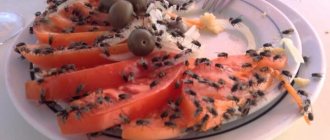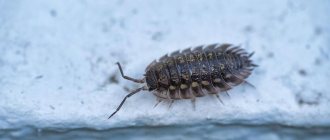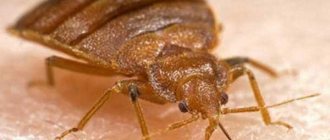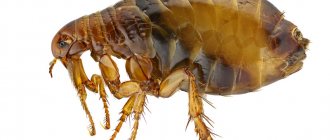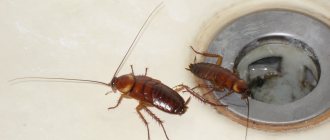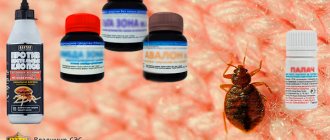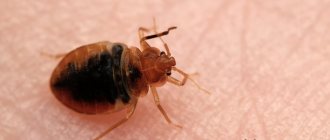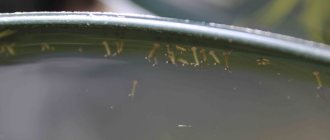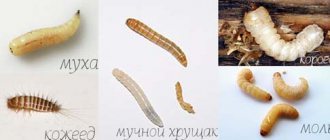- Drosophila fruit flies - a brief description
- Midge development
- Sex differences in a nutshell
- Laying eggs
- Pupation of the Drosophila fly
- Brief life of an adult Drosophila
- How to get rid of Drosophila flies An important factor in the destruction of Drosophila melanogaster
- Find and neutralize
- Prevention is the best measure
- Funnel trap
Everyone, both urban and rural residents, has encountered fruit flies. It would seem that what is the problem, let them fly - they live short, do not bite, are almost harmless. But there are situations when getting rid of such crumbs is more difficult than getting rid of cockroaches, so it is better to be prepared.
Drosophila fruit flies - a brief description
There are many small flies in nature, more than 2000 species, and they are sometimes confused with other flies, although fruit flies have a number of features so as not to be confused with fungus gnats or sewer midges.
Table of differences between fruit flies and other small midges:
| Insect name | Photo | Preferred habitat | Features of “appearance” |
| Sewer flies (butterflies) | Climbing out of the sink, bathtub | They seem fluffy. Black, wings clearly visible, widely spaced | |
| Fungus gnats | Wet soil in flowerpots (plants begin to wither) | Inconspicuous, do not bite | |
| Clothes/food moth | Wardrobes and chests of drawers containing natural fabrics or furs. For food moths, reserves of cereals and seeds are interesting | Grayish insect, leaves gray “pollen” when touched | |
| Mosquitoes | Available everywhere, especially where it is warm and damp | Places with food remains, garbage, rotting fruit | |
| fruit fly | They bite, squeak, get in your eyes | They do not buzz, sit and fly quietly, “impressively”. They fuss only around the food source. |
Drosophila are called differently depending on where they were found in a given area. They are most often found in spoiled fruits, which is why they got their name fruit fly. And because they simply adore sour, young wine, wine vinegar is a “vinegar” or “wine” fly.
Drosophila melanogaster prefers plant debris, juice, and rotting fruit. And the larva does not disdain microorganisms. The larvae develop in semi-rotten raw materials - neither a solid nor a liquid consistency is suitable for young larvae, but a viscous one is excellent.
Drosophila melanogaster is a tiny dipterous insect. Available almost anywhere in the world.
It enters human habitation by crawling into cracks or open holes when it smells the appetizing aromas of fruit rot.
It is also carried by pets on their fur. They are often brought along with vegetables and fruits from the store, on the soles of shoes.
Getting to know the insect
Midges are small insects whose size barely reaches 5 mm.
Most species have completely miniature sizes - 2 mm. They live everywhere, with the exception of Antarctica. All phases of development, until the insect reaches the imago stage, midges spend in an introductory environment. The family has about 1,800 species; the European temperate climate is inhabited mainly by fruit flies, whiteflies, and sciarids. Only a knowledgeable entomologist can determine the differences between them. The poor fellow, bitten by a midge, has no time to determine the species, and all the vileness looks the same to him. Midges
Interesting!
In most species, only female midges feed on the blood of warm-blooded insects. Males eat exclusively fruit or flower nectar.
People who live near bodies of water or travelers in the taiga and tundra are most aware of how midges bite. As experienced people say, a midge in the taiga will be worse than a mosquito. Hordes of insects are called nothing more than midges. Rivers and lakes with running water are mandatory conditions for the reproduction of insects. Females lay their eggs on plant stems and stones in ponds. Some individuals specifically go underwater to lay offspring. Other females do not bother themselves with diving skills and drop their eggs on the fly. If you take a portion of water from the bottom of a river or any other body of water, using a magnifying glass you can see tiny worm-like white larvae.
The peak of activity begins in mid-April, early May and ends only by the end of June. In the northern regions, midge activity decreases after snowfall. Insects feed only during the daytime in sunny weather. On a rainy, cloudy day, no midge activity was recorded at night. Insects live in flocks containing myriads of individuals. People and animals suffer from midge bites. There are known cases where tens of thousands of cattle died from attacks by the Colombian midge in the Danube countries.
Midges
Review
“One day in late spring, my family and I came to visit relatives living on the banks of the small river Khoper. Suspecting nothing, we decided to get out into nature and relax on the river bank. We drove up to the shore and, inspired by the view of the spring landscape, quickly got out of the car. And then it started! Swarms of small midges swarmed around us and began to bite us furiously, tiny insects getting into our mouths and noses. The child immediately ran into the car, and we adults still tried to resist. But neither running fast nor waving branches helped. I had to leave the inhospitable shore; it’s good that at least no one was allergic to the midge bite. Local residents then laughed at us and said that the midge would disappear only after the flood and the June haymaking.”
Valentina Vladimirovna, Balashov
Laying eggs
Drosophila eggs look like thin cylinders, up to 0.6 mm. They are clearly visible against a dark background. One female is capable of laying more than 1,500 eggs in her life (up to 20 eggs in each clutch). To lay eggs, it selects fruits with a soft consistency. They can also lay their offspring in drains.
The environment in which the larva hatches determines the future of the adult fly. The larva must eat as much as possible during this period, accumulating a lot of nutrients. This will allow her to grow into a larger individual and significantly increase her chances of survival.
After hatching, the larvae crawl along the surface, then gnaw through the medium and remain inside until pupation.
Appearance and activity
Drosophila or fruit flies live next to people in apartments and houses, since the most favorable conditions are created for them there.
Flies have several subspecies, but most of their characteristics are the same:
- Length. It does not exceed 3 mm, females are slightly larger than males.
- Color. Most insects are light brown in color, but black, dark brown, yellow and orange individuals are also found. They also have red eyes, dark stripes on the back of the abdomen, and transparent wings that are longer than the body.
- Reproduction. A female Drosophila can lay up to 400 eggs in her life, so the insects reproduce very quickly.
- The lifespan of a fly under favorable conditions is about 2.5 months.
- Larval development. About 10 days pass from the moment the egg is laid until the adult appears, provided that the temperature is above 25°C. Otherwise, the duration of this cycle increases by 2 times.
- Already on the second day after metamorphosis, insects become reproductive, females begin to lay eggs.
- Drosophila don't bite.
- Flies do not tolerate cold. They are able to live only at temperatures above 18°C.
Pupation of the Drosophila fly
The larvae crawl briskly around the environment, but no longer eat anything. Having found a suitable place, they stop moving, shrink and become like a barrel. All organs and tissues are destroyed, only the nervous system and gonads (organs that produce germ cells) remain, and the rudiments of the adult organs develop. The entire conversion process takes 4 days.
By the beginning of the 4th day, the pupa’s eyes are already clearly visible, which are initially yellowish (by the time they hatch, they become red), and the wings are increasingly visible. In the end, liquid accumulates inside the pupa, which breaks the dense cover, and the fly is freed. The “birth” of a fly occurs in the morning.
Features of bloodsucker bites
As noted above, only females can bite. They need blood to mature their eggs. Midge bites are comparable to a surgical procedure. They do not pierce the skin, but literally gnaw it out, at the same moment the insects inject an anesthetic substance, which allows a person not to experience pain until the parasites have had their fill. At the same time, the annoying bloodsucker introduces an enzyme that prevents blood clotting.
The insect's saliva contains toxic substances for the human body, as a result of which swelling and redness, burning and severe itching appear at the site of the lesion. Numerous bites can cause fever, swelling of internal organs and, in rare cases, cause death.
Midge bite in the eye
The reaction to a midge bite varies from person to person and depends on age, pain threshold, number of lesions, and tendency to allergies. Severe itching causes the desire to scratch the areas caused by midge bites. Even an adult cannot resist this, let alone children who tear apart the affected areas until blood appears. As a result, the situation is aggravated by the penetration of bacteria. Photos of a midge bite are presented below.
How to get rid of fruit flies
The crazy fertility of the fruit midge leads to the fact that it is enough to go away for the weekend and forget the ripe fruit on the table, so that in a couple of days the whole apartment will be covered with black clouds that will be everywhere, on all surfaces and crevices.
After the destruction of most of the insects, more and more hordes appear the next day. And each baby leaves behind not only many clutches of eggs, but also black spots of feces on everything where it sat. Therefore, the plan to combat the wine fly must be quick and effective, otherwise the war will drag on and the forces will not be on the side of man.
Plan for getting rid of fruit flies:
- Deprive them of any food source.
- Find and eliminate places where insects and midge eggs are located.
- Carry out preventive measures.
Fruit midges fly slowly, but they have excellent vision and are good at noticing fast or sudden movements, while calm, slow ones will not scare them away.
The midge suffers greatly from lack of moisture. Almost not afraid of frost, loves alcohol, especially wine and beer.
An important factor in the killing of Drosophila melanogaster
The most important and effective means in the fight against fruit flies is to deprive flies and larvae of food. This means that you need to remove any fruits, vegetables, sugary drinks, canned food, especially spoiled and spoiled foods.
Find and neutralize
Be sure to find places where adults and larvae are located. Wash everything, destroy spoiled items, put away bags of nuts, cereals, open jam and compotes or hide them in the refrigerator.
Kill fruit flies using chemicals or various baits. Large accumulations can be removed using a vacuum cleaner.
Prevention is the best measure
Those who have the habit of clearing everything from the table immediately after eating, storing food in airtight containers or the refrigerator may never encounter fruit flies or cockroaches.
The main condition for preventing these annoying neighbors is to remove all food and liquids, leaving it perfectly clean. Insects will not have anything to eat or where to lay eggs, and they will move to places with more hospitable owners.
Prevention measures
To prevent Drosophila flies from appearing in your home, the following conditions must be observed:
- If fruits and vegetables can be stored in the refrigerator, then keep them in the fresh zone to kill fruit fly eggs;
- wash fruits and vegetables with cold water immediately before eating;
- do not leave fruits unharvested;
- promptly separate rotten fruits and vegetables from fresh ones;
- throw away garbage in a timely manner so that the rotting process does not begin;
- Install protective insect nets on windows in the warm season - get rid of flies, flies, and mosquitoes.
Making your own fruit fly traps
Funnel trap
The simplest option is to place a fragrant bait in any container, and place a lid, watering can or cone on top, allowing insects to crawl inside but not crawl out. Seal the edges of the trap so that insects have only one entrance and no gaps.
When the trap is black with prisoners, they need to be destroyed. There can be many ways: add water (can be hot), heat it in the microwave for a minute, release it outside, put it in the freezer, etc.
Another trap option is with vinegar.
Pour a drop of wine or apple cider vinegar into the bottom of the container, add a pinch of salt, warm water and a couple of drops of dishwashing detergent. Mix everything and put it in a visible place
You can catch fruit flies with live beer, crushed ripe banana, sour compote or honey water - in a minute hundreds of insects will rush to the sweet delicacy.
First aid for midge bites
If it so happens that you are bitten by a midge near your home, you can provide first aid to the bitten person, which will reduce the consequences:
- First of all, it is recommended to find the site of the bite, identifying the location by the characteristic “hole”. Next, you need to squeeze it to remove any remaining poison from the wound. It is advisable to repeat this procedure several times.
- Next, you need to rinse the bite site with plenty of water to wash away any remaining toxic saliva.
- Blot the bite area with a napkin, removing excess water. At the same time, you should not rub this place, since you can aggravate the consequences of the bite; you need to carefully blot the wound.
- Next, the question arises of how to relieve swelling and prevent severe swelling. To relieve swelling, apply ice to the swollen area of the body. Next, treat the bite site with an antiseptic, which is available in the house.
- You can take antihistamines and painkillers.
After providing first aid, be sure to monitor the well-being of the bitten person and the bite site itself. If you miss time and do not start treatment on time, if complications arise, you can end up in the hospital.
Also, if symptoms of a severe allergic reaction appear, you should consult a specialist.
Drosophila as a pest
This small lionfish is dangerous because in large quantities it can spoil a huge amount of ripe fruits or vegetables - having started on a spoiled fruit, it gradually devours the soft and ripe one nearby. Therefore, it is considered a pest of food supplies.
Drosophila stains food with waste products and carries microorganisms that lead to rapid rotting or fermentation of fruits and vegetables.
If you swallow several flies, there is a possibility of gastrointestinal infection or myiasis (when insect larvae develop in the human body and make holes and passages in its organs).
Additional methods
If there were few insects or there was no desire to make something, you can drive out fruit flies with the help of pungent odors. Essential oils and other aromatic agents will help “smoke” them. Midges cannot tolerate :
- pine needles, lavender, citrus fruits (oil should be used in an aroma lamp);
- the smell of heated camphor;
- incense;
- the aroma of dried herbs like wormwood, tansy or lavender.
If you have dried bouquets of similar plants on your farm, you should lay them out or hang them up.
Benefits of fruit flies
Aquarists and fishermen love these midges most of all because their larvae are excellent food for fish at all stages.
The role of this baby is also great in science, especially in genetics. Their fleeting life and the ease of changing characteristics make it possible to trace the transmission of genetic characteristics live within a few months (the method of dominant mutations, etc.).
And the fact that more than 60% of human diseases have corresponding diseases in the genetics of this insect makes it possible to model genetic diseases by observing several generations of midges. The important role of fruit flies in the study of Alzheimer's, Parkinson's, diabetes, cancer, and drug addiction.
What should you do if your leg or arm is swollen, painful and itchy after an insect bite?
Treatment of a victim of a midge bite should begin with first aid. This will prevent the occurrence of negative consequences and alleviate the condition of a bitten child or adult. Only after this can you begin symptomatic therapy aimed at getting rid of swelling, itching, burning, pain and redness.
First aid for victims - adults and children
If a child or adult has been bitten by these insects, the first thing to do is:
- Determine the location of the lesion and remove any remaining saliva from the wound. To do this, gently squeeze the skin several times.
- Wash the wound with plenty of running water and baby or laundry soap to wash away any remaining saliva.
- Dry the wound with a clean napkin using light blotting movements.
- Treat the affected area with an antiseptic (Furacilin, Chlorhexidine).
After providing emergency assistance, victims, especially children, should not be left unattended. If the bitten person’s health has worsened, and the affected area hurts unbearably, has become even more swollen and red, it is necessary to take him to the hospital.
Symptomatic therapy: how to relieve swelling, reduce pain and itching?
If a person has become a victim of a midge bite, after which the affected area is swollen, redness and severe itching appear, and this happens in most cases, measures must be taken to alleviate his condition. Symptomatic therapy can be based on the use of pharmaceutical preparations for external use (ointments, gels) or folk remedies. It all depends on the severity of the discomfort.
Pharmacy drugs
It is not enough to apply ointment or gel to itchy and swollen skin once. It is necessary to smear the affected area until itching and swelling are completely eliminated. Topical products should be used in strict accordance with the manufacturer's recommendations. This is the only way to quickly and without the risk of further aggravating the situation to eliminate the consequences of the bite of these insects. The table provides information about which ointments and gels can be used to do this:
| Type of body reaction to an insect bite | Drugs | |
| Itching | Local antiallergic drugs | gel Fenistil, Psilobalm |
| Edema | Hormonal decongestant ointments | Hydrocortisone, Sinaflan, Trimistin |
| Wound infection | Antiseptic ointments | Levomekol, Oflocain, Levosin |
| Violation of the integrity of the skin | Regenerating agents | Panthenol, Solcoseryl, Bepanten, Actovegin |
If there is extensive swelling that extends to skin areas distant from the site of the lesion, you may need to:
- injection administration of antihistamines (Tavegil, Suprastin, Diphenhydramine);
- use of glucocorticosteroids (Dexamethasone, Hydrocortisone, Methylprednisolone);
- treatment with decongestants (L-lysine escinate, Mannitol, Furosemide).
When using hormonal ointments, one nuance must be taken into account. If you apply them to open wounds, it will cause a strong burning sensation and slow down tissue regeneration. It is recommended to apply them along the edges of wounds.
Folk remedies
If an insect bites you on the leg or arm and a mild reaction is observed in the affected area, folk remedies will come to the rescue. When using them, you need to know for sure that the bitten person tolerates the components included in their composition well. The table provides information on what methods, based on the use of natural ingredients, can treat the consequences of bites from these representatives of dipterans:
| Types of body reaction to an insect bite | Components | Preparation | Application |
| Edema | Dandelion or plantain | Knead the thoroughly washed plant with your hands. | Apply the plant to the affected area, securing it with adhesive tape. |
| Onion | Grate the vegetable on a fine grater. | Apply onion or potato pulp to the swollen area. | |
| Potato | |||
| Itching | Peppermint paste or mouthwash | Not required | Apply paste to the itchy skin or wipe with a cotton pad soaked in mouthwash. |
| Boric alcohol or aqueous solution of boric acid | Treat the affected area with liquid. | ||
| 3% vinegar | Mix vinegar and water in equal proportions. | Make a compress by applying a piece of gauze soaked in the product to the itchy skin on your leg or arm and securing it with an adhesive plaster. | |
| Salt | Dilute 1 tsp. salt in 200 ml of water. |
Preventive measures
If you adhere to basic rules, it will help you completely forget what these annoying insects look like. The appearance of insects in an apartment is a signal to reconsider some habits and start putting things in order in the house. That's why:
- Dishes should be washed immediately after eating and dirty dishes should not be allowed to accumulate in the sink.
- Empty the trash can regularly and promptly, especially in the warm season.
- Regularly wash and dry cloths in the kitchen and bathroom.
- Do not store vegetables, berries and fruits outside the refrigerator.
- Water the plants only when necessary.
- If plants are fertilized with tea leaves, then it is necessary to regularly remove its remains and not allow it to begin to rot.
- Dishes for cats and dogs should be kept clean, as should their trays.
- If Drosophila flies appear in your home, then the fight against them should not be postponed until later, since they reproduce quite quickly if conditions contribute to this.
Order and cleanliness in the house is a guarantee that such insects will never become interested in a person’s home. Conversely, a mess in the house is the conditions that attract not only fruit flies, but also other, more dangerous pests.
What medications will help a child at home?
Almost every mother in her home medicine cabinet has Zvezdochka balm or cosmetics used after insect bites: creams, ointments, pencils. It is better to always take such preparations with you on a walk so that, if necessary, you can quickly apply them to your baby’s wound.
As soon as the parents notice that the child has been bitten by an insect, and the affected area is itchy and painful, it is necessary to disinfect this area of skin. Solutions of Furacilin and Chlorhexidine have antiseptic properties. When rinsing the eyelid at home, you need to be extremely careful to prevent the drug from getting on the cornea.
How to relieve swelling?
The bite of a black midge causes severe swelling of the skin. The following remedies will help alleviate the victim’s condition:
- first you need to rinse the affected area with cold water in order to eliminate any remaining poison as quickly as possible;
- You need to apply a cold compress to the swollen area;
- anoint the redness around the wound with Fenistil, Advantan, Zvezdochka or Rescuer balms, Boro Plus;
- Furosemide tablets and injections can relieve extensive tissue swelling;
- in case of a bite in the eyelid area, if the eye is swollen, vasoconstrictor eye drops Polynadim or hydrocortisone ointment will help relieve swelling (we recommend reading: what to do if a child has swollen eyes?).
Elimination of itching and redness
To relieve allergy symptoms (itching and redness), oral administration of antihistamines (Tavegil, Suprastin, Diazolin) and the use of local agents (Fenistil-gel, Advantan) are indicated. Alcohol compresses or lotions with novocaine cope well with itching.
If the bite site is very itchy and there are no antihistamines at hand, in this case Corvalol or Valocordin will help treat the disease. You need to apply a few drops of the product to the itchy area, and within a few minutes it will stop itching.
Treatment of allergies to midge bites
To block the manifestation of an allergy to an insect bite, it is necessary to take an antihistamine as quickly as possible. Such drugs begin to act 15-20 minutes after administration, and the effect lasts throughout the day.
If this is not the first time an allergic reaction has occurred in your baby, it is recommended to take an antihistamine for several days until the characteristic symptoms completely disappear. In this case, it is better to visit a doctor so that he can prescribe the appropriate drug treatment, calculate the dosage of the drug and the duration of its use.
Antipyretics and other drugs for symptomatic treatment
It happens that the baby’s condition after an insect attack is accompanied by weakness and hyperthermia. In this case, the doctor prescribes additional medications to eliminate symptoms:
- antipyretics (Nurofen, Ibuprofen, Paracetamol);
- anti-inflammatory medications;
- in severe cases - antibacterial drugs;
- wound healing ointments.
What not to do after a bite
The itching caused by midge venom is so severe that even an adult finds it difficult to resist scratching the skin. And what can we say about kids, who find it difficult to explain the danger of the current situation. When scratching, wounds and microcracks appear, into which pathogenic bacteria easily penetrate. After a few days, ulcers and suppuration may join the symptoms of an allergic reaction. Therefore, dermatologists in the treatment of edema in children focus specifically on eliminating skin itching. What else is strictly forbidden to do after being bitten by midges:
- to take a bath;
- apply decorative or caring cosmetics to unaffected areas of the skin;
- self-medicate;
- Apply menthol ointment to open wounds.
At the healing stage of damaged skin, it should not be treated with solutions containing aggressive chemicals. These drugs include external agents containing ethyl alcohol.
Warning: If the wound is suspected of becoming infected and pathogenic microorganisms have entered the bloodstream, the doctor prescribes drugs with antibacterial activity in the form of tablets or suspensions. You should not ignore the doctor’s recommendations and not take such medications. Pathogenic bacteria can cause severe infectious diseases
How long does a midge bite take to heal?
How long the swelling from a bite lasts depends on your health condition. On average this is:
- For mild skin reactions – from 1 to 4 days.
- For local allergies – from 4 days to 1.5 weeks.
- For an initially severe allergic reaction – from 1 to 2 weeks.
In addition to allergies, the duration of the presence of edema can also be affected by the location where it is located and the rate of metabolic processes in the body. With proper treatment and supportive care, intense swelling in most cases is relieved within 1–3 days; further recovery gradually eliminates the remaining symptoms within 10–14 days. How long the bite lasts and how long it takes for it to heal completely so that not a trace remains of it depends on the speed of skin cell regeneration, which is also highly individual and can take from a week to 1 month or more.
